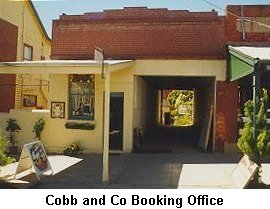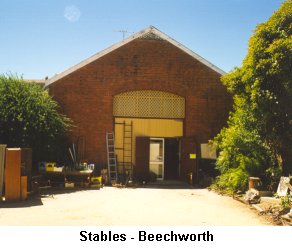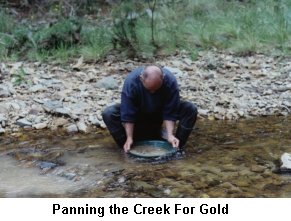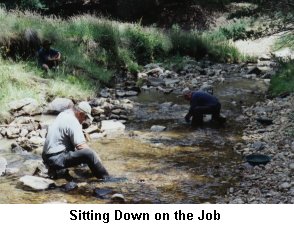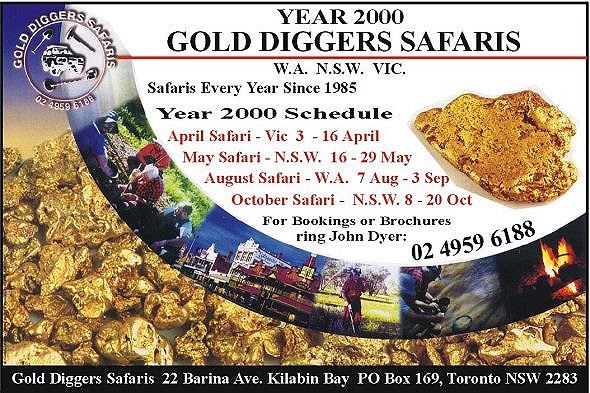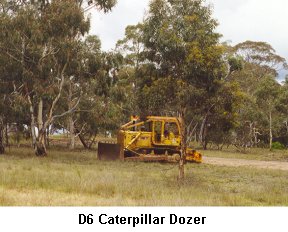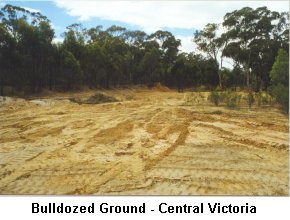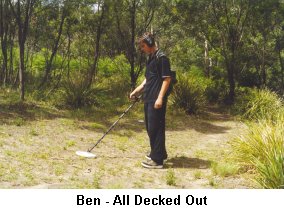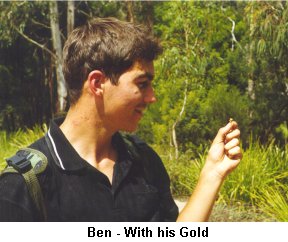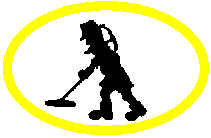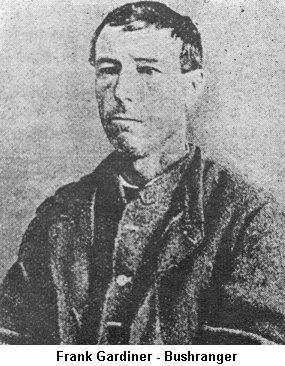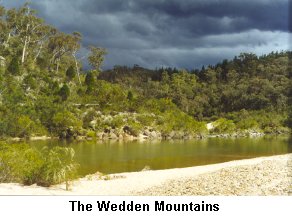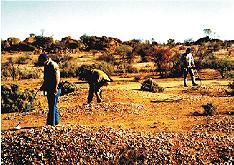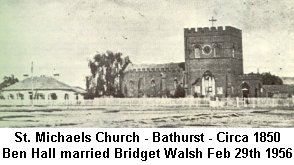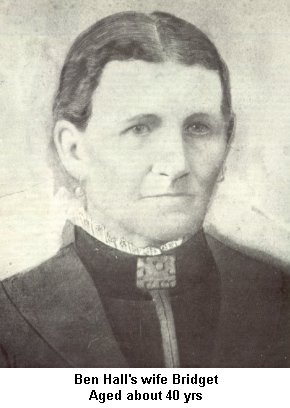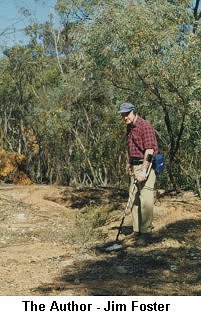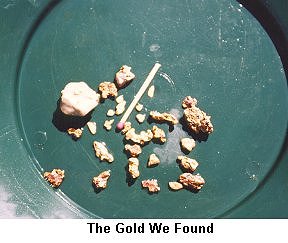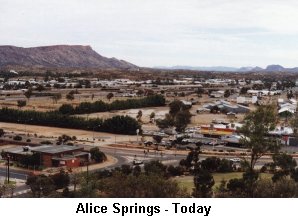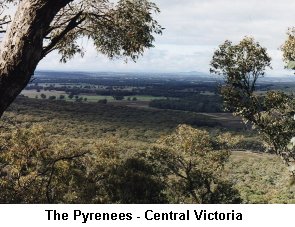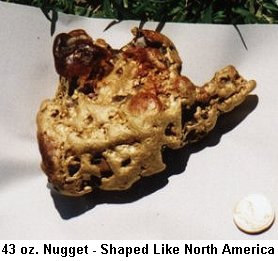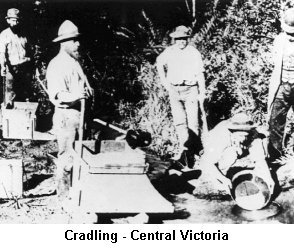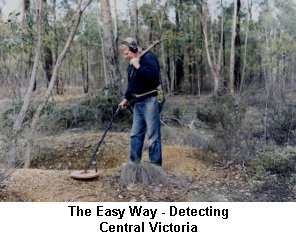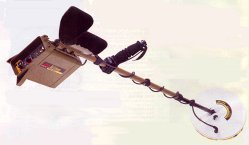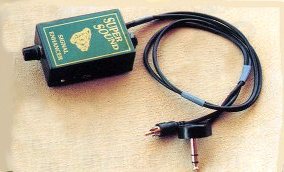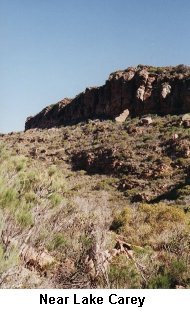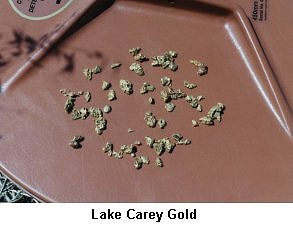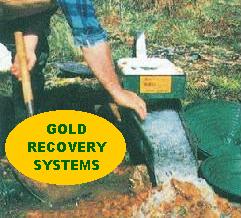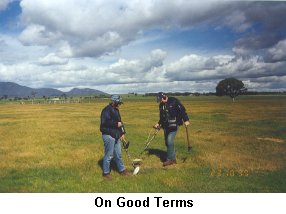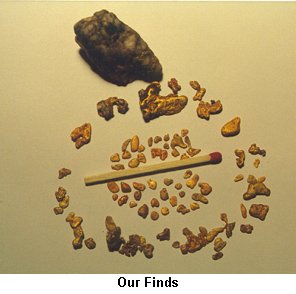
| February 2000 | ||||||||||||||||||||||||||||
|
||||||||||||||||||||||||||||
Contents
|
||||||||||||||||||||||||||||
| 1. EDITORIAL This month we seem to have an abundance of articles relating to Bushrangers. However we make no apologies for this as these outlaws were colourful characters and were so much a part of the gold history of this country. With so many convicts released from penal settlements into the fledgling Australian colonial community, one can understand that banditry was indeed considered by many to be a noble profession. The most famous of these bushrangers were ironically not transported, but were reputedly born and bred Australians. Brought up in the harsh and tough regions of the Weddin Mountains, far away from the harsh law and order that commanded the times in Sydney and its surrounds. These men were known collectively as the Wild Colonial Boys. Their exploits, deeds and sheer audacity, were lauded within their local communities. They were folk heroes in their time, and remain to this day, legendary folk heroes. Perhaps the two most famous of these outlaws were Frank "The Darkie" Gardiner, and Ben Hall. Both were tough men and Australians to the core, whose lives became intertwined and whose criminal activities today remain unsurpassed. They were regarded as gentlemen robbers within their own domains, but history and fact reveal their gentlemanly aura's were somewhat a facade. Their legends make fascinating reading.
Email: [email protected] All material in this magazine is copyright and may not be reproduced in any part or form whatsoever without written permission from the publisher.
|
||||||||||||||||||||||||||||
|
2. COBB & CO. IN AUSTRALIA - PART 4 by Craig Wilson
Cobb & Co had several factories that were making coaches and undertaking repairs. The main factories in Victoria were at Castlemaine and Sandhurst.
The activities of these organisations were not just confined to building coaches for Cobb & Co. They were engaged in all manner of coach building, including hearses and purpose built vehicles for all occasions, upon order. In 1876 the railway finally reached Bathurst. Although some may have thought this would be the end of Cobb & Co. Not so - in fact it enhanced the business opportunities further west linking those remote towns with the train connection at Bathurst. The drivers of the coaches were held in high esteem and it should be noted that the retired drivers association continued at least until the end of the Second World War. Meetings were regularly held in Melbourne, and a plaque was affixed to a building in central Melbourne in 1946.
There is much confusion as to who actually owned coach runs throughout Australia during this period. It is fair to say that Cobb & Co. only held a small percentage of the total business, but their coach building activities, with the manufacturers name emblazoned on the side of the coach, operated by other firms in fact, gave the appearance that the company was operating throughout the entire country. The company did not always win in the war for market share either. In one exceptional example, on the lucrative run from Bourke in north west New South Wales to Adelaide, the competitor offered free passage. The company matched this. But when the competitor offered free meals and free overnight lodging, the company wisely withdrew from the contest. It was often thought that Cobb &Co. carried the Royal Mail throughout Australia. This is simply untrue. The highest contracts the company procured were in New South Wales in the latter part of the 1880's with a total of about 30,000 pounds. The mail carried within Victoria by the company was much less. However the reputation that Cobb & Co. developed as a reliable carrier of mail was legendary, and today stand as a fitting memorial to the company.
During the 1890's a serious of disastrous droughts enveloped the entire country.
Business dropped off dramatically and the company's reserves were tested to the limit. So much were they stretched out in Queensland where the company held mail contracts, that the company sought relief.
Rutherford himself somehow obtained a large number of the properties that had been bought with the company's money. Just how he acquired these is unknown, but they were extensive holdings.
With the advent of motorised vehicles, the horse drawn coach was fast disappearing from the Australian landscape.
Freeman Cobb returned to the United States when he sold his company, and built himself a large mansion at Brewster, Mass. He married, but his activities within the US are shrouded in mystery. Among other things he was reputed to have had a coach line from Mexico to California, and in 1864 he was said to have an interest in the Adams Express Company. James Rutherford continued in the fine tradition of Freeman Cobb and enhanced the legend of Cobb & Co. that is so highly thought of by historical scholars throughout Australia and the world. The pioneering spirit, ingenuity and business acumen of these two men stands unchallenged, and their reputations as fine contributors to the development of this country is deservedly lauded.
|
||||||||||||||||||||||||||||
|
||||||||||||||||||||||||||||
|
||||||||||||||||||||||||||||
|
||||||||||||||||||||||||||||
|
3. OVER AT OBERON by Laurelle Murphy I had heard that some lucky nugget hunters had struck it rich up near the Fish River, somewhere near Oberon. They had apparently been panning and had been lucky enough to find several nuggets. Now being interested in anybody talking about finding gold anywhere, I made some inquiries with an old friend, who I knew would have heard the news. He is a cunning old fox, and a man with his ear to the ground 24 hours a day, seven days a week. When I phoned Will and exchanged the usual pleasantries I quickly moved the conversation to the gold at Oberon. Yes, of course he knew about it. He had been told before the entire world knew about it and he knew exactly the location where some good slugs had been recovered only last week. Oh yes, he would be there next Sunday without fail to test the water himself. I was excited, but tried to disguise my pleasure, but it was clear from the tone of my voice that I was delighted at the prospect of working this area. Although Oberon is only some 80 miles due west of Sydney it is a little tucked away off the main roads and with a population of only 4,000 the country yokel mentality is evident as I was to find out in a telling way later in the day. Many of the farms in this area still have no government supplied electricity, and must generate their own power.
What stood out here were the spectacularly ornate stone bridges, culverts, and retaining walls - undoubtedly convict built. They were plentiful and I wanted to stop and make a close inspection, but we were already late. Now for obvious reasons I have been asked not to disclose exactly where this place is that I was taken, but suffice to say that it is north east of Oberon, and somewhere near the Fish River. I can say that it was fabulous State Forest country, and with recent rains the rivers and creeks were flowing splendidly with crystal clear water at good strength. It was just sufficient to pan pleasantly away in perfect conditions.
We had to tramp what seemed forever across several rather enormous hills and over several difficult creeks before we reached the spot. It was almost 11am before we finally reached our destination. A strong flowing meandering creek, that was a tributary of the Fish River. Finally, totally zonked, well at least I was, we reached the perfect location to pan. When I had recovered enough, it was pointed out to me that the bend in the creek previously was a good indicator of gold and with a large wash away below this point about 20 yards downstream this is where we would do our first digging. With the invitation in place, my "riend" then handed me the shovel, and promptly lay down on the creek bank with a sly grin to watch the proceedings.
Well he is a sly old fox and before I had even turned around he was in the water with the shovel full of wash dirt waiting for me to return. His grin was infectious, and from what had been a long silence, we both laughed together and then got stuck into the task at hand. He knew there was gold there as he had worked the area the day before. As the day wore on the gold was getting better. Almost every pan full we were getting about 10 - 15 specks, and at times we were getting small nuggets up to about half gram in weight. Will worked hard with that shovel and I washed away for about 6 hours straight. Darned hard work, but in the end even after 6 hours the gold was still there. Although the gold was there, the realisation that in the morning I had to front for work unfortunately began to drive me towards leaving this fabulous area. I wanted to stay, I was having such a fantastic time. Trudging back to the vehicles the way seemed easier, although I was dog tired. We said our farewells, which included the mandatory hug and kiss to this old gentlemen, who is so sharing with his knowledge, and I headed back into Oberon to refuel. Asking a local at the service station which way was the quickest way to Goulburn, the next town south, I was met with a very blank expression, and the comment "I don't know, I only live here". Well having refuelled, I took the bit between the teeth and headed due south through Black Springs towards Goulburn. I had never been on this road before and although a good part of it was dirt, it ran almost entirely along the Great Dividing mountain range for almost 50 miles or so. The evening sun was highlighting the trees and the mountains. The bird life was incredibly prolific, with scores of sulphur crested cockatoos adorning the old dead gums that stood as lone sentinels in clearings. Storm clouds were gathering but the sun was still shining strongly across the mountains. It was an awesome trip only broken by an incredibly steep descent and ascent through the Abercrombie River Valley, and then again to the top of the range.
It was well dark by the time I reached home. I was so tired I could hardly climb the stairs to the front door, but what a day it had been. I had thoroughly enjoyed myself and we had got a good amount of gold. Speaking of the gold, where was my share? The cunning old fox had outfoxed me again.
|
||||||||||||||||||||||||||||
|
||||||||||||||||||||||||||||
|
||||||||||||||||||||||||||||
|
||||||||||||||||||||||||||||
|
4. BULLDOZING FOR GOLD by John Douglas Finding gold any way you like can be a hard exercise, and to be successful one must be tenacious in their endeavours. The days of simply digging promising ground with a pick and shovel are well and truly over, with modern detectors taking over from that back breaking task, targeting nuggets in the dirt that make recovery so much simpler.
Panning on the other hand is still the time honoured back breaking method that the old timers used, as in Australia, mechanical means of gold recovery is not permitted by amateurs.
On some gold leases mainly in Western Australia, where the auriferous ground is so extensive, bulldozing for gold has been developed into an art form. Depending on the location, gold leases can be purchased for a few thousand dollars upwards to tens of thousands of dollars, for the right to work the auriferous ground both on top and below the surface, down to bed rock. The process is simple. Once a lease has been purchased and permission from authorities obtained, an area of promising ground is marked out, usually in a straight line. The surface is then ripped using the bulldozers large rear tines, to a depth of somewhere between 9" and a foot, depending on the hardness of the ground being worked. The dozer blade then pushes the surface dirt off the ripped area. Following up with detectors the newly exposed surface is then extensively detected, usually two or three times.
Using a bulldozer may seem a slight overkill to the uninitiated, but the auriferous ground in Western Australia is highly mineralised and exceptionally heavy, with a strong component of rocks and mineral content, packed down hard, and being very difficult to dislodge, without using heavy equipment. Some areas in Victoria have been bulldozed in this manner, but by the time one goes through the process of gaining the necessary permits etc. The process is a mine field of negotiations and hardly worth the effort. The huge gold fields of western Australia are the easiest to bulldoze and extensive works are carried out in this manner. It should be recognised that once the dirt removalists have completed working the area, there is a statutory requirement to restore the ground to its original state. In other words, the dirt must be replaced and vegetation restored where possible, to near its original position. It can be a time consuming and expensive exercise. There are no guarantees with gold recovery and the cost of fuel and maintenance on a dozer in such a remote area can he pretty thick.
The dozer ground is generally situated around the Leonora Laverton area in south central Western Australia. It is a long way from anywhere. The closest capital city is Perth, some 400 miles away. Mechanical services and parts, if required may take some time to arrange. Delays of up to 7 to 14 days can be expected. Mechanics in this part of Australia, are thin on the ground, let me tell you. There is always the problem of security. Being out in the donga, (bush) security is always a problem and it is usually necessary to have someone with such expensive equipment twenty four hours a day, seven days a week, while the dozer and the fuel are on site.
Needless to say, there are quite some difficulties in organising and administering an undertaking of this nature. But the gold spirit is strong in Australia and there are plenty of people who will take on this type of gold recovery operation.
I have looked at it carefully myself, and with a partner who owns at dozen bull dozers working around the country, one day we just might have one on a low loader running past a lease I know I can get hold of pretty cheaply. I am just having a little difficulty in convincing him at the moment, that it is a good idea.
The logistics for me would be simple, for him a little harder. Perhaps that's why there is some hesitation on his part.
|
||||||||||||||||||||||||||||
|
||||||||||||||||||||||||||||
|
||||||||||||||||||||||||||||
|
||||||||||||||||||||||||||||
|
5. THE NOVICE by John "Nugget" Hunter
Detecting is an art form. There is no doubt about it. You are either real good at it, or you end up putting the detector in the top of the cupboard or selling it. Ben is a normal 17 year old. Enthusiastic, full of life, and with an expectation that life will be good to him. Like most kids that age, a degree of expected immortality creeps into his life style. So it was that the week after he concluded his school exams that we headed off to some diggings I knew not far from the Braidwood, not that far east of Canberra.
It had been unseasonably wet that week, and the rain had put a damper on my detecting activities for 4 days, so I too was keen to get back into the gold fields. Braidwood was better known for the alluvial creeks and rivers that abound in the surrounding mountains. However there are some good spots where nuggets have been located in recent years.
Eventually he came back to me, a little less enthusiastic in his manner.
We had a long discussion about detecting in general. We talked about the lay of the ground, the signs that diggings give and above all the slow and methodical way that an experienced detectorist operates. I stood back and watched him for a few minutes. He was certainly heading in the right direction now. I again took up my own Minelab 2200d selecting the 10" elliptical mono coil that is so successful on old heaps. Ironically I didn't find a scrap for the rest of the day. That old gold field had been thoroughly cleaned out. But that's detecting for you. One day a feast the next a famine. In retrospect perhaps I should have been using a wider coil, but I really wasn't there to satisfy my own needs, I was there to help Ben.
He didn't want to leave that spot but at the same time wanted to get home and show his find to his parents and his friends. Oh - the enthusiasm of youth. Would be that I could muster that strength and enthusiasm again. Good on you Ben! I know you'll find lots more gold out there now and I hope you do.
|
||||||||||||||||||||||||||||
|
||||||||||||||||||||||||||||
|
6. THE LOST TREASURE OF FRANK GARDINER by Katherine Knight One of the great mysteries of the bushranger years, is just where did the bushrangers hide their booty? Undoubtedly many of them squandered their ill-gotten gains, but it was well known that at least two, Ben Hall and Frank Gardiner had their booty well hidden. Ben Hall had converted his to cash and it was safely hidden in a friend's bank account. Unfortunately his friend found the reward money and the 6,000 pounds that was lying in his own bank too much to endure and was probably the principal behind Ben Halls demise, when he was betrayed and shot dead by a large police party. Frank Gardiner on the other hand was a highly intelligent and charismatic individual. He was a sound organiser and had planned single handedly the hold up on the Eugowra Gold Escort where a huge haul of gold and notes had been taken from the escort police, on Sunday 15th June 1861. The value was in total about 14,000 pounds. A huge amount, even for those golden days. Not long after the robbery the booty was divided equally among the eight who had taken part and the robbers parted company to avoid the traps (police).
Gardiner knew he had to lie low, and was well hidden in the Wedden Mountains, but police patrols were still very active and their activities, even to gain food and water, were precarious.
Gilbert managed to find Gardiner rather quickly, and the next day a group of six bushrangers held up the police party and recovered their two mates.
This embarrassing event added ridicule to the police, and with this in mind police patrols were intensified.
The intensity of the police activity resulted in many arrests, most of them Gardiner's associates. The next day he discussed with Kate Brown the situation and together they decided to move to Queensland, almost 1,000 miles to the north. No one was aware that Gardiner had left New South Wales and the police continued to blame him for almost every robbery that occurred west of Sydney town. While the police were rounding up dozens of suspects in relation to the escort robbery Gardiner was establishing himself in respectable business at Aphis Creek, near Rockhampton, Queensland.
The famous bushranger was now a prosperous storekeeper on the main road to the Peak Downs goldfield. In fact he was in partnership with a Mr Craig, and were living a most respectable life.
Amazingly before a jury of 12 men he was found "Not Guilty". The judge was shocked and upon application of the prosecution remanded the prisoner in custody for further charges to be laid. Gardiner was a model prisoner and was not without his supporters. Almost immediately the petitions for release began. After serving just 12 years of his 32 year sentence the government relented and released a number of bushrangers, among them Gardiner. The conditions set for his release included a clause exiling him from Australia, and so it was that in July 1874, Frank Gardiner was taken under guard to Newcastle and placed aboard the barque Charlotte Andrews, bound for Hong Kong. He was then 44.
From this British protectorate he made his way to San Francisco later that same year and there purchased the Twilight Saloon at 1031 Kearney Street, near Broadway.
In 1879 he took over a saloon at 318 Brannan Street, San Francisco. But what happened to Gardiner's treasure? There are many legends and theories that abound regarding the whereabouts. Perhaps the most credible and authenticated version relates possibly to Gardiner's twin sons. In 1912, a Mr. Jack Butler, then the owner of "Wheogo" the property on which Gardiner was supposed to have buried his treasure, was visited by two Americans, calling themselves Monty and Fred. They claimed to be mining engineers prospecting for radium. Butler gave them permission to camp and work on his property.
After about a week they departed taking several bags of "rock specimens" with them to Grenfell, where they immediately caught the train to Sydney carrying the specimens with them. Later it was discovered that the only work carried out were diggings to a depth of about two feet on the summit of Mount Wheoga.
|
||||||||||||||||||||||||||||
|
||||||||||||||||||||||||||||
|
||||||||||||||||||||||||||||
|
7. BEN HALL - BUSHRANGER - PART 1 by Craig Wilson In the history of banditry recorded in this world very few men could live with the awesome reputation that was bestowed on Ben Hall. Not only by those he robbed, and by his pursuers, but also by those who knew him, as an "honourable" thief. Bandits or Bushrangers, as they were known in Australia were prolific in number, which is not surprising as most of the inhabitants of the penal colony of New South Wales were send here in chains and had been released after serving their sentences. Most, who came here in a variety of both private and naval vessels of the British had been imprisoned for life. Some had received a lesser sentence for petty larcenies and the like, of 7 years hard labour.
So it was that one Ben Hall senior, then aged 25 years, arrived in Sydney Cove, Australia in 1827 having been convicted of stealing. His previous criminal history had been extensive and he had been part of an organised gang and he had at least two prior convictions. His sentence was 7 years. As a trustee he was assigned to one of the many wealthy squatters who had land grants of several thousand acres, and it was his duty to tend sheep during the day. Fences at that time in this vast land were few and far between. Far cheaper to employ a trustee for his board and keep than to build fences in those days.
In less than 3 years Hall had a small stake of over 100 sovereigns and he was hell bent on finding himself a wife. He was 32 years of age, and not that acquainted with the fair sex. It was the custom of the day to find a wife in Sydney town, usually from the trustee prisoners who had been transported and worked in the Female Factory - making clothes, at Parramatta.
Eventually, Ben senior came under the notice of the police, and following a complaint had a warrant to answer the charge of cattle thieving. As the traps, (police) were coming for him he was warned by friends of their approach and barely escaped their clutches. For over a year he worked well away from his home, under an alias, leaving his beloved Eliza and his children to fend for themselves. But alas, some evil "friend" eventually betrayed him to the police and he was arrested. Some years passed. By the time young Ben was 15, he was an accomplished horseman and was fearless. He was working as a stockman on a property in the Wedden Mountains. It was reputed that on one occasion when a young bull gored a small child, Ben jumped into the yard with a large mallet and stood between the prostate youth on the ground and the bull. As the bull charged, Ben stood his ground and smashed the bull between the eyes with the full force of a well-aimed blow, stunning the beast. A further two blows, had the huge beast stunned and on his knees. The lad was rescued and young Ben acclaimed as a hero.
In December 1860 Ben Hall and his friend John McQuire drove a small herd of cattle from Wheogo to the nearby gold diggings to sell at good prices to the diggers. As they camped for the night near the diggings a stranger rode up and in the failing light introduced himself. "My name is Gardiner - Frank Gardiner. I am a partner in Gardiner and Foggs, butchers of Spring Gully". An event took place on the morning of the 14th April 1862 that was to change Ben Hall's life forever. Hall had been suspected of petty theft and he had become involved again with Frank Christie, alias Frank Gardiner. Gardiner was a wanted man as he had escaped the traps (police) by shooting his way out of a hut seriously wounding a sergeant and a trooper in the exchange. Hall, Gardiner and another accomplice held up and robbed three teamsters who were travelling along the road at the same time. After the robbery Gardiner rode away with his booty into the scrub as did Hall and his employee, in another direction. A week later, at a picnic race meeting, the police were humiliated when on the first day of proceedings, a large number of bushrangers attended, and mingled in the crowd, away from the site of the police. However that night the police commander Sir Frederick Pottinger, was made aware of their presence, and he was informed by one of the teamsters that Ben Hall had been with Gardiner when he had been robbed.
The next day Ben Hall again, attended the race meeting and was promptly arrested and charged with "Highway robbery under arms".
|
||||||||||||||||||||||||||||
|
||||||||||||||||||||||||||||
8. FLECKS ! - Glints from here and there
|
||||||||||||||||||||||||||||
|
||||||||||||||||||||||||||||
|
9. BIG GOLD DAY by Jim Foster The melodic call of a butcher bird heralded another dawn in the Western Australian Goldfields. Then came the playful minah birds, calling gleefully to each other as they played slippery-slide down the sloping canvas roof of our camper awning, already the warming sun could be felt through the canvas. I lay in bed for a few minutes reviewing the previous days prospecting. It had been pretty bad. Everywhere we had been it seemed someone had been there before us. Every good looking bit of ground we tried had been cleaned out. It had been very depressing with no gold being found all day. But today was another day. Cheryl opened one eye and grinned, already she was keen to get out there and reverse the previous misfortune. Breakfasting outside in the sunshine I watched the local bird life going about their lives and envied them a bit, but then I saw one energetic minah struggle with a fat grub and envied them no more. Breakfast over we checked our gear then drove off looking for new ground to detect. We were using the newest and latest Gold Detectors, the SD2200D from Minelab Electronics Australia. My machine was fitted with the latest search coil from Coiltek, the double D wound 14", plus we were using audio boosters. Some time later we spotted some likely looking ground and began our search. Again we found others had been there before us, but we persisted, as it didn't look as if any of the old dig holes had been made in the last couple of years. Then Cheryl quietly called and held up one finger. Out here you don't shout out your finds, there are too many people around who could clean out a patch while you are back in camp. Cheryl then held up three fingers, indicating the nugget weighed about three grams (31.2 grams per ounce). I grinned back and gave her a thumbs up before continuing my own search.
Excited now, I slowed my search, concentrating hard. Then I got a soft, wide signal that indicated a deep target. Exploring the signal I noted it was about three feet wide. This was good. It indicated the target was large. There was an almost imperceptible harder centre to the target but it was still only a soft sound, even with the coil hard down on the ground. Looking around I saw what looked like a small indicator reef running parallel to the top of the low rise I had crossed. I was about thirty feet below the reef and the ground looked deeper where I stood. Chucking my battery belt I took my pick and began shaving the ground over the signal. It looked like being a long way down to the target so I began the hole about three feet across knowing that it would taper as I went down. Picking up the detector I swept the coil across the target. The signal hadn't got much louder which indicated the target was indeed very deep, or it was just a patch of heavily mineralised ground. But I was now allowing myself to get excited about the prospect of some bigger gold. Switching the SD2200D to Auto Ground Track I swept the coil across the signal area several times, but the signal did not diminish in the least, indeed it seemed, if anything, to get louder. I was confident now this signal was gold and let the excitement have full reign.
All day we dug nuggets, mostly small, but very bright and sharp. Most of the gold had travelled only a short distance from the reef it had shed from. After finding the easy gold I tied my gridding chain to my belt and gridded every square inch of that slope. I turned up another couple of ounces that we'd missed first time around. Then, down near the bottom of the slope Cheryl found a signal that was so wide and loud it could only be another deep nugget. By taking it in turn to dig, then dig and pound with the crow-bar we were soon near the nugget. To say we were excited understates our feelings. Our eyes gleamed and we wore silly grins as we tried to guess the size of the gold. At last the nugget was out of the hole and in the heap of dirt. Cheryl found it first and let out an involuntary whoop before covering her mouth with a dirty hand and breaking into a fit of laughter. I took the nugget from her and wiped some of the dirt and rock from it. It didn't look much like gold. Coated in pale cap-rock only a gleam here and there, and the weight, betrayed that it was gold. Eight and a quarter ounces it weighed when later cleaned. That was Cheryl's biggest ever nugget and wasn't she happy with it! We worked hard until dark but could only find another couple of tiny nuggets on the slope. We headed for home with our gold safely tucked away and as we drove I thought of yesterdays trip home and the depression we were feeling. Todays big gold had changed all that. And that is what detecting for gold in the Western Australian Eastern Goldfields is all about. Nothing one day, sometimes nothing for several days. But persevere with the search and you too can have a big gold day. DETECTING WESTERN AUSTRALIA'S EASTERN GOLDFIELDS Gold can be found anywhere in this huge state, in fact two thirds of the state is auriferous. Not only can gold be found but also nickel, iron, silver, coal, and the worlds largest deposits of gemstone diamonds are to be found in Western Australia, not to mention a veritable cornucopia of lesser, semi-precious gemstones. But for detecting for nuggets it is the nation's main winter destination. Thousands of people flock eastward every year to lose themselves in the bush while searching for gold.
Very few, if any, return east empty handed. Indeed, some will return home with that nugget of a lifetime that weighs in the scores of ounces, while many will find nuggets in excess of ten ounces. Those that miss out on the big ones will often find more weight in the scores of smaller nuggets they find. Prospecting for gold can be done by living out in the bush for several months, or living in one of the many nearby caravan parks. Some even live in motels or hotels in Kalgoorlie travelling out each day to detect. Some join tagalong tours or all-inclusive luxury detecting tours. But whichever way you choose you can be sure you are going to find gold in one of the world's last great wilderness. |
||||||||||||||||||||||||||||
|
||||||||||||||||||||||||||||
|
WE BUY GOLD GOOD QUALITY NUGGETS REQUIRED TOP PRICES PAID Currently seeking nuggets from 6 grams upwards. Gold nuggets sold on consignment 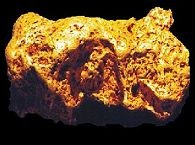
PO Box 533, KENT TOWN 5071 Mobile: 0417 848 910 E-mail: [email protected] |
||||||||||||||||||||||||||||
|
||||||||||||||||||||||||||||
|
10. LOST MINES by John Robson The vast gold fields of Australia hold many secrets. None more alluring or intriguing than the rumours of lost mines. With the enormous amount of gold getting activity that proliferated in the 1850's, and with the vastness of the auriferous areas just how many mines rumoured and real that are "lost" is a matter of conjecture. The one fact that stands out though is that there are literally dozens, perhaps hundreds of mines that were still producing good gold when for numerous reasons they were lost. Secrecy was of paramount importance in keeping the gold mines safe from claim jumpers, robbers and other miners who were legitimately seeking gold. Consequently the locations of these golden holes in many instances has been lost due to the passing of the old timers who jealously kept their secrets to their graves. The most famous lost mine in Australia is undoubtedly "Lasseters Reef". This golden reef that Lasseter claimed to have located in the last decade of the 1800's has never been located. Despite many expeditions which included one with Lasseter himself as guide in 1930, the lost mine has not been relocated. This of course begs the question - did this fabulous wealth ever exist. Research indicates that Lasseter's story may not in fact be totally truthful, but that begs the question - where did he get the gold that he had supporting his claim. Many old prospectors from Australia's Red Centre that knew the area well, all claim that there is no auriferous country in the region that Lasseter was searching. There is no question that Lasseter was in the Western Australian gold fields in the late 1800's and may have met up with the geologist Harding who was rumoured to have found gold in the Northern Territory. Just what is the truth will probably never be known.
The Lost Chinaman's Mine in Victoria's Pyrenees, somewhere west of Avoca has never been found. This was not a rumoured mine but was well known to exist by the old timers as the Chinese continued to work the area for a long time. There is no doubt they were getting good gold from this mine.
The area is remote and the terrain difficult, and although there are some obvious diggings that are easily accessible, this mine has never been found. As a young boy I can recall an old farmer from the Adelaide Hills near Echunga discussing with my father the gold that was supposed to be found in the creek that ran through our property. It undoubtedly existed then and would still exist today as the area has never been worked. What attracted me though was when the old man mentioned an old mine that he knew of just a few miles up the road in a hilly and well wooded area. I remember driving up there one day and wandering over to the side of the hill and took a look around. It was fairly well over grown then, and by now some 40 years on I don't even think I could find it again. It certainly existed. I saw it myself. I actually found it, walked around it went just inside the tunnel and then left again.
Just how many lost mines are there in Australia? The answer must be in the hundreds, maybe even more. The fact remains that they are there just waiting for that lucky treasure hunter to rediscover and reap the huge rewards that undoubtedly lie hidden in this vast country. Amazingly very little research is carried out on lost mines and a wealth of information is available in archives that are easily accessed. This untapped source can even pinpoint lost mines if enough research is carried out. Library resources in Australia are extensive and readily available.
I for one wont stop looking for those lost mines. They are hidden, but throughout this vast auriferous land some will undoubtedly be found.
|
||||||||||||||||||||||||||||
|
||||||||||||||||||||||||||||
|
||||||||||||||||||||||||||||
|
||||||||||||||||||||||||||||
|
11. STRIKES Recent Finds
|
||||||||||||||||||||||||||||
|
||||||||||||||||||||||||||||
|
||||||||||||||||||||||||||||
|
||||||||||||||||||||||||||||
|
12. THE HARD WAY by Cheryl Foster The old time prospectors had it hard. They had to work their way up streams and gullies following the run of gold. A time consuming and back breaking business that involved a lot of detective work. Tracing the signs of gold back to its source sometimes made the lucky prospectors extremely wealthy. But at other times they found just enough gold to buy rations. When the gold thinned out they left to look for better prospects. What they left behind is what you are looking for. Often the old timers gave up just short of a rich patch of gold. THE EASY WAY Old timers had only their sharp eyes and strong backs to find gold. You have the latest in electronic gold finding machines. In one day of casual coil swinging you can search the same amount of ground that would take an old timer weeks. As weekend prospectors we don't want to work too hard, but we want to find gold. You can waste a lot of time and energy searching the wrong ground if you don't know where to go. Research is the best way to put yourself on good ground. Read everything you can find dealing with the history of gold in the area you are concerned with. Visit the nearest town to that goldfield and ask the local librarian for everything that may be a help to you. Your local detector shop will also be of great help. Most of them carry goldfield maps and books designed to help you get the most out of your detector. But nothing beats local research. ON THE DIGGINGS Having got yourself onto your chosen area take a walk, without your detector. Look at the edges of the old diggings for side gullies and slopes where the diggings become very shallow. Some hillsides may have been "surfaced". That is, all the gold bearing gravel and dirt lifted and carried away to be puddled for its gold content. All that will remain will be a bare clay slope. Surfaced areas are good starting points for detecting. Look around the edges and up-slope for that patch of nuggets the old timers didn't quite get to. Search the heaps as well, listening hard for that faint signal that may be a deep nugget. MOTHER LODE
Following the gully uphill may bring you to where the gold was shed, the mother lode. This could be the spine of a quartz reef. Search all sides sloping away from any such reef. GOLD IS WHERE YOU FIND IT Many times I have seen new chums searching ground that experienced prospectors shunned. Many times I have seen these same new chums strike it lucky. One new chum found a four ounce nugget on ground that was thought to have been thrashed out, and that was his first trip out with a club. Don't be put off by finding lots of detector holes on an area you wish to search. Work that ground hard. Don't drive from diggings to diggings looking for ground no one has yet searched, you won't find any. Find a bit of ground that your research shows as promising and stick at it. Work it slowly. Keep your coil close to the ground and listen hard. Don't worry about what others have found in that area, it's what you are going to find that matters. Gold is where you find it.
|
||||||||||||||||||||||||||||
|
||||||||||||||||||||||||||||
|
||||||||||||||||||||||||||||
|
||||||||||||||||||||||||||||
|
13. THE WONDERLAND OF LAKE CAREY by Jim Foster We'd heard of Lake Carey, and other lakes like it in Western Australia. We had seen gold found on these strange lakes of salt. The gold had been a wonderful bright colour. Gold from the salt lakes, we were told, was always brighter as the salt leached out the staining ironstone leaving the nuggets very pure. One of the prettiest nuggets I have ever seen came from Lake Carey. It was, as near as I can remember, around nine or ten grams and seemed to glow from an inner light. SALT AND QUARTZ
Now the day had come and we stood on a low cliff with our friends, Reno and Greeta from Adelaide, who had guided us there, overlooking the lake. It didn't look too remarkable from our vantage point. Stretching away to the south we could see the shine of clean salt and the hard glisten of quartz here and there but it wasn't quite what we'd imagined. While the others began detecting I took my photographs and was delighted by the shades and texture of the cliffs contrasting with the lake bed. Photos taken I joined the others detecting. The glistening salt was strewn with water-worn pebbles and sand. The salt making my detector whine and moan as it noisily protested the mineral salt. I hadn't expected this. Our detectors were the SD2200D models. Mine was fitted with a Coiltek 14" double D coil while Cheryl was using her standard 11" double D coil. It wasn't until I dug my first signal that I realised why the detectors were making such a fuss. The first signal was a wide, soft, sound just like ground noise but with a slightly harder centre to it. Circling the signal in "auto tracking mode" I then switched back to "fixed". The signal improved and I began to dig. At first the ground was damp, gravelly stuff then I was into gluey blue clay that was difficult to dig and hard to shake off the pick. At about six inches I checked the hole. The signal was still there and louder now. The dirt out of the hole gave quite a good signal too, but was now identifiable as mineral salt noise. Being damp all the way down, and saturated with mineral salt the ground was why the SD's were having a hard time. Had the ground been dry there would have been little problem. At about a foot down I had the target out of the hole. I wasn't at all excited as I'd never detecting on a lake bed before and didn't know how far rubbish could sink. Anyway, I hardly expected my first target to be gold. But it was! A beautiful, gleaming, Lake Carey nugget shone through the gooey clay. Cleaning it as much as possible by hand I then popped it into my mouth for that final clean, and nearly spat it out again in surprise. Not only do nuggets from salt lakes look better, they taste better, too. Rolling that lump of gold around in my mouth I savoured the salty tang before spitting it out and drying it. It lay in my hand, a wonderful bright eight grammer, my first from the lake. The others crowded around to admire my nugget and we all went back to work with high hopes of more. Two hours later we decided that if there were more nuggets there they were darned thin on the ground and decided to explore the main lake. FLOATING ISLANDS
Halting on the edge of the main lake bed we made our plans. Never before had any of us driven out on a salt lake bed, we had no idea what to expect. Caution was the key. We reckoned that if we drove several hundred metres apart, if one vehicle got in trouble the other could pull it out. We used only two wheel drive to prevent ourselves from driving deeper into trouble. We reckoned that if stuck, one pulling the other, and all in four wheel drive, we'd have no trouble getting out.
Walking away from the vehicles I studied the ground. Tracks of emu, kangaroo, and goats, could be plainly seen imbedded in the soft surface of the lake. Fainter tracks showed where a dingo or dog had scouted the lake bed. Even fainter tracks, easily identified, had been left by a fox. A dog or dingo will leave claw marks as they walk or run. A fox, like a cat, walks with its claws sheathed. Only when running hard will a fox use its claws for extra traction. Then I saw something that puzzled me; many small bird tracks. What sort of bird lived out here? I wondered. Looking through the binoculars I looked around. Movement caught my eye and I knew I'd found the birds. Too far away to identify, all I could see was that they were small and grey, with long thin legs, not unlike a curlew. I moved toward them but they ran quickly away, maintaining their space. THE LAKE SHORE
The wind, which had been a stiff breeze before, was now swooping up the lake with the intention of becoming a full gale. I'd heard stories of how wind can drive water before it over a flat lake bed, trapping vehicles when the clay becomes too wet to enable friction. We went to move off, and didn't move at all! Leaving the vehicle idling, and still in gear, I got out. The two rear wheels were turning on a thin layer of greasy clay. Already the tyre tread was full, lessening the traction even more. LAKE GRIDDING Heading for the western shore we came across parallel tyre tracks that appeared to have been made by a ride-on-lawn mower. Only a couple of metres apart the tracks ran north and south for as far as we could see. It seemed someone had detected the lake bed using a large patch-finder coil behind either a quad bike or a mower. If they found much they filled their holes in very well because we crossed those tracks for nearly a kilometre and saw only one hole. COMPANY ON THE LAKE Driving into the mouth of a small inlet we found shelter from the wind and had lunch. While eating we saw three other people searching further in on the shore of the inlet. They'd obviously found some gold as they were concentrating hard on a small area. We watched with interest as they dug a few signals but we had no way of knowing if they were digging nuggets or rubbish. After lunch we gave our own end of the inlet a going over but found nothing despite the interesting quartz reefs that abounded there. MORE TASTY GOLD
Our last stop for the day was a patch of dry-blow heaps we'd passed on the way in. This patch was on a slope, part of the lake shore. The old timers had found gold in two small gullies running down to the lake and on a small flat on the higher ground. Greeta was the first to strike gold. She found a very pretty nugget in the first gully she tried. Her first off the lake.
|
||||||||||||||||||||||||||||
|
||||||||||||||||||||||||||||
|
||||||||||||||||||||||||||||
|
||||||||||||||||||||||||||||
|
14. GOLD FEVER by Jim Foster
Gold can do funny things to people. I've seen good friends become enemies over a single nugget. I've seen club members go out and buy nuggets just so they can win a cheap monthly trophy. It's even happened to me.
Not long ago I was working in a high powered industry where performance counted for everything. Being of a competitive nature I took on more and more work until I was at burn-out point. Under this stress a day here and there nugget hunting wasn't easing the pressure, then I snapped. I became intensely jealous when anyone else found gold. I became nasty and introverted with my friends. Luckily I saw what was happening and quit that job. Now I'm a much nicer person again. But even now, there are times when I have to remind myself that I should feel glad when others do well. I call this Bad gold fever. Good gold fever is when you enjoy the search more than the finding of gold. When you enjoy the company of good friends around a campfire under the big, big sky of the Australian outback. When your glad that your friend found a nugget.
One night while moonlighting, a very good site, one of the guys, Rob, found three nuggets in quick succession. I couldn't find a thing. Then the other bloke, Terry found two good bits. Still, I couldn't find anything. Sitting down for a while I wracked my brains as to what I was doing wrong. Ten minutes later I decided to try what I'd worked out. Darn me, it worked! Three nice gold nuggets saw the moon for the first time that night. I was as happy as Larry, but as we called it quits and were walking back to the car, Rob snipped the best nugget for months. Talk about excited! We all admired that nugget and tried for more, but nothing else was there, it was a lone nugget. We were all happy for Rob, but not as happy for Rob as Rob was. I look back on those days of moonlighting with fondness and a sense of loss of days gone by. All that time and we never let the Bad gold fever get us.
The first time I found a big nugget in Western Australia Cheryl watched me dig the hole, then dived on the uncovered nugget in a fever of excitement for us both. That night we celebrated with the bottle of champagne we'd kept for just that occasion. There is no doubt about it, gold fever is the best fever to have, especially when you can celebrate success together. Long the live good gold fever!
|
||||||||||||||||||||||||||||
|
||||||||||||||||||||||||||||
|
15. THE NEW LODE - Next Month's Issue
|
||||||||||||||||||||||||||||
|
||||||||||||||||||||||||||||
